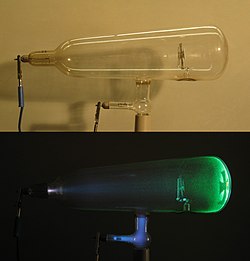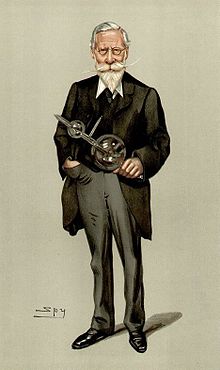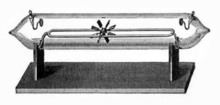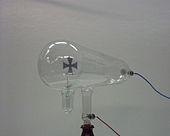Crookes tube

A Crookes tube (also Crookes–Hittorf tube)
Developed from the earlier
Wilhelm Röntgen discovered X-rays using the Crookes tube in 1895. The term Crookes tube is also used for the first generation, cold cathode X-ray tubes,[5] which evolved from the experimental Crookes tubes and were used until about 1920.
Operation

Crookes tubes are
When high
Enough of the air has been removed from the tube that most of the electrons can travel the length of the tube without striking a gas molecule. The high voltage accelerates these low-mass particles to a high velocity (about 37,000 miles per second, or 59,000 km/s, about 20 percent of the speed of light, for a typical tube voltage of 10 kV[6]). When they get to the anode end of the tube, they have so much momentum that, although they are attracted to the anode, many fly past it and strike the end wall of the tube. When they strike atoms in the glass, they knock their orbital electrons into a higher energy level. When the electrons fall back to their original energy level, they emit light. This process, called cathodoluminescence, causes the glass to glow, usually yellow-green. The electrons themselves are invisible, but the glow reveals where the beam of electrons strikes the glass. Later on, researchers painted the inside back wall of the tube with a phosphor, a fluorescent chemical such as zinc sulfide, in order to make the glow more visible. After striking the wall, the electrons eventually make their way to the anode, flow through the anode wire, the power supply, and back to the cathode.
The above only describes the motion of the electrons. The full details of the action in a Crookes tube are complicated, because it contains a nonequilibrium
History
Crookes tubes evolved from the earlier

By the 1870s,
What was happening was that as more air was pumped out of the tube, there were fewer gas molecules to obstruct the motion of the electrons from the cathode, so they could travel a longer distance, on average, before they struck one. By the time the inside of the tube became dark, they were able to travel in straight lines from the cathode to the anode, without a collision. They were accelerated to a high velocity by the electric field between the electrodes, both because they did not lose energy to collisions, and also because Crookes tubes were operated at a higher
This accidental fluorescence allowed researchers to notice that objects in the tube, such as the anode, cast a sharp-edged shadow on the tube wall.
At the time, atoms were the smallest particles known and were believed to be indivisible, the electron was unknown, and what carried
The colorful glowing tubes were also popular in public lectures to demonstrate the mysteries of the new science of electricity. Decorative tubes were made with fluorescent minerals, or butterfly figures painted with fluorescent paint, sealed inside. When power was applied, the fluorescent materials lit up with many glowing colors.
In 1895, Wilhelm Röntgen discovered X-rays emanating from Crookes tubes. The many uses for X-rays were immediately apparent, the first practical application for Crookes tubes. Medical manufacturers began to produce specialized Crookes tubes to generate X-rays, the first X-ray tubes.
Crookes tubes were unreliable and temperamental. Both the energy and the quantity of cathode rays produced depended on the pressure of residual gas in the tube.[13][14][15] Over time the gas was absorbed by the walls of the tube, reducing the pressure.[16][13][14][15] This reduced the amount of cathode rays produced and caused the voltage across the tube to increase, creating more energetic cathode rays.[15] In Crookes X-ray tubes this phenomenon was called "hardening" because the higher voltage produced "harder", more penetrating X-rays; a tube with a higher vacuum was called a "hard" tube, while one with lower vacuum was a "soft" tube. Eventually the pressure got so low the tube stopped working entirely.[15] To prevent this, in heavily used tubes such as X-ray tubes various "softener" devices were incorporated that released a small amount of gas, restoring the tube's function.[13][14][15]
The electronic
The technology of manipulating
Discovery of X-rays


When the voltage applied to a Crookes tube is high enough, around 5,000
On November 8, 1895, Wilhelm Röntgen was operating a Crookes tube covered with black cardboard when he noticed that a nearby fluorescent screen glowed faintly.[18] He realized that some unknown invisible rays from the tube were able to pass through the cardboard and make the screen fluoresce. He found that they could pass through books and papers on his desk. Röntgen began to investigate the rays full-time, and on December 28, 1895, published the first scientific research paper on X-rays.[19] Röntgen was awarded the first Nobel Prize in Physics (in 1901) for his discoveries.
The many applications of X-rays created the first practical use for Crookes tubes, and workshops began manufacturing specialized Crookes tubes to generate X-rays, the first X-ray tubes. The anode was made of a heavy metal, usually
Experiments
During the last quarter of the 19th century Crookes tubes were used in dozens of historic experiments to try to find out what cathode rays were.
Maltese cross
Perpendicular emission

Eugen Goldstein in 1876 found that cathode rays were always emitted perpendicular to the cathode's surface.[22][23] If the cathode was a flat plate, the rays were shot out in straight lines perpendicular to the plane of the plate. This was evidence that they were particles, because a luminous object, like a red hot metal plate, emits light in all directions, while a charged particle will be repelled by the cathode in a perpendicular direction. If the electrode was made in the form of a concave spherical dish, the cathode rays would be focused to a spot in front of the dish. This could be used to heat samples to a high temperature.
Deflection by electric fields
Deflection by magnetic fields


Crookes put a magnet across the neck of the tube, so that the North pole was on one side of the beam and the South pole was on the other, and the beam travelled through the magnetic field between them. The beam was bent down, perpendicular to the magnetic field. To reveal the path of the beam, Crookes invented a tube (see pictures) with a cardboard screen with a phosphor coating down the length of the tube, at a slight angle so the electrons would strike the phosphor along its length, making a glowing line on the screen. The line could be seen to bend up or down in a transverse magnetic field. This effect (now called the Lorentz force) was similar to the behavior of electric currents in an electric motor and showed that the cathode rays obeyed Faraday's law of induction like currents in wires. Both electric and magnetic deflection were evidence for the particle theory, because static electric and magnetic fields have no effect on a beam of light waves in vacuum.
Paddlewheel

Charge
Anode rays

Goldstein found in 1886 that if the cathode is made with small holes in it, streams of a faint luminous glow will be seen issuing from the holes on the back side of the cathode, facing away from the anode.[24][25] It was found that in an electric field these anode rays bend in the opposite direction from cathode rays, toward a negatively charged plate, indicating that they carry a positive charge. These were the positive ions which were attracted to the cathode, and created the cathode rays. They were named canal rays (Kanalstrahlen) by Goldstein.[26]
Doppler shift
Lenard window

See also
References
- ^ T. A. Delchar, Physics in Medical Diagnosis, Springer, 1997, p. 135.
- S2CID 122178245.
- ^ "Crookes Tube". The New International Encyclopedia. Vol. 5. Dodd, Mead & Co. 1902. p. 470. Retrieved 2008-11-11.
- ^ "Crookes tube". The Columbia Electronic Encyclopedia, 6th Ed. Columbia Univ. Press. 2007. Retrieved 2008-11-11.
- ^ Mosby's Dental Dictionary, 2nd ed., 2008, Elsevier, Inc. cited in "X-ray tube". The Free Dictionary. Farlex, Inc. 2008. Retrieved 2008-11-11.
- ^ Kaye, George W. K. (1918). X-rays, 3rd Ed. London: Longmans, Green Co. p. 262., Table 27
- ^ Tousey, Sinclair (1915). Medical Electricity, Rontgen Rays, and Radium. Saunders. p. 624. Archived from the original on 2016-07-12. Retrieved 2008-11-12.
- ^ Thomson, J. J. (1903) The Discharge of Electricity through Gases, p.139
- ISBN 978-0-19-851997-3.
- Thomson, Joseph J. (1903). The Discharge of Electricity through Gases. USA: Charles Scribner's Sons. p. 138.
- ^ a b Thomson, Joseph John (1903). The Discharge of Electricity Through Gases. Charles Scribner's Sons. pp. 189–190.
ether corpuscular theory.
- ^ Thomson, J. J. (August 1901). "On bodies smaller than atoms". The Popular Science Monthly. Bonnier Corp.: 323–335. Retrieved 2009-06-21.
- ^ a b c Kaye, George William Clarkson (1914). X rays: an introduction to the study of Röntgen rays. London: Longmans, Green and Co. pp. 71–74.
pressure progressive hardening time progressively lower.
- ^ a b c Crowther, James Arnold (1922). The Principles of Radiography. New York: D. Van Nostrand Co. pp. 74–76.
pressure reduces increases soft hard.
- ^ ISBN 978-9400987852.
- ^ Dushman, Saul (1922). Production and measurement of high vacuum. New York: General Electric Review. pp. 123, 174.
x-ray tube hardening pressure disappears increases.
- ^ The energy and penetrating ability of the x-rays increases with the voltage on the tube. Tubes with voltages below 5,000 V also create x-rays, but they are "soft" enough that very few penetrate the glass envelope of the tube.
- ^ Peters, Peter (1995). "W. C. Roentgen and the discovery of X-rays". Textbook of Radiology. Medcyclopedia.com, GE Healthcare. Archived from the original (Chapter 1) on 2008-05-11. Retrieved 2008-05-05.. There are many conflicting accounts of the discovery because Röntgen had his lab notes burned after his death. This is a likely reconstruction by his biographers.
- doi:10.1038/053274b0., a translation of his paper read before the Wurtzberg Physical and Medical Society, December 28, 1895.
- ^ Brona, Grzegorz; et al. "The Cathode Rays". Atom - The Incredible World. Archived from the original on 2009-02-11. Retrieved 2008-09-27.
- ^ Pais, 1986, pp. 79-81.
- Thomson, Joseph J. (1903). The Discharge of Electricity through Gasses. USA: Charles Scribner's Sons. p. 138.
- ^ Goldstein E. (1876). Monat der Berl. Akad., p. 284.
- ^ Goldstein E. (1886) Berliner Sitzungsberichte, 39, p.391
- ^ Thomson 1903, p.158-159
- ^ "Concept review Ch.41 Electric Current through Gasses". Learning Physics for IIT JEE. 2008. Retrieved 2008-11-11.
External links
- An illustration of a "maltese cross" Crookes tube.
- The Cathode Ray Tube site
- Crookes and Geissler tubes shown working
- Java animation of a Crookes tube
- "The Cathode Rays". Library. Oracle Thinkquest Education Foundation. Archived from the original on 2008-05-06. Retrieved 2008-04-28. History of d
- Jenkins, John. "Crookes and Geissler tubes". Spark Museum. Retrieved 2008-04-29.






